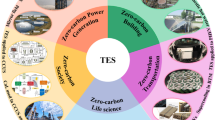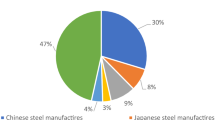Abstract
Development of the low-emission energy technologies including renewable energy sources, electric vehicles, and energy storage facilities make up the core of global carbon neutrality scenarios. These technologies stand out by their increased materials intensity, in particular that of energy-intensive materials: steel, aluminum, polymers, silicon, copper, lithium, nickel, cobalt. The article introduces a method for calculating and assessment of the global energy consumption to sustain carbon neutrality scenarios. Currently, the infrastructure of the low-emission economy consumes 0.4% of the world’s energy. By 2050, this should increase by almost 20 times and exceed the current energy consumption of metallurgy and the construction materials industry.
Similar content being viewed by others
Notes
NGFS, Network for Greening the Financial System.
A.Yu. Kolpakov and A.A Galinger, “Economic efficiency of the spread of electric vehicles and renewable energy sources in Russia,” Herald Russ. Acad. Sci. 90, 25–35 (2020). https://doi.org/10.1134/S1019331620010165.
A.Yu. Kolpakov, A.A. Yantovskii, and A.A. Galinger, “The cost of achieving zero CO2 emissions by the middle of the century: A method and assessment for the world’s largest economies,” Zh. Novoi Ekon. Assots., No. 3, 139–154 (2022). doi 10.31737/2221-2264-2022-55-3-7.
Values of 2019 or 2021 were used as indicators of modern production, depending on the available data.
REFERENCES
IEA, World Energy Outlook 2021, 2021. https://www.iea.org/reports/world-energy-outlook-2021.
IEA, Net Zero by 2050, 2021. https://www.iea.org/reports/net-zero-by-2050.
IEA, The Role of Critical Minerals in Clean Energy Transitions, 2021. https://www.iea.org/reports/the-role-of-critical-minerals-in-clean-energy-transitions.
G. Callaway, Ch. Ding, T. Fitzgibbon, H. Gregor, M. N. Malik, and M. Smith, Could supply-chain issues derail the energy transition?, McKinsey and Company, December 2022. https://www.mckinsey.com/industries/oil-and-gas/our-insights/could-supply-chain-issues-derail-the-energy-transition#/.
McKinsey, The net-zero transition: What it would cost, what it could bring, 2022. https://www.mckinsey.com/business-functions/sustainability/our-insights/the-net-zero-transition-what-it-would-cost-what-it-could-bring.
NGFS, NGFS Climate scenarios for central banks and supervisors, 2021. https://www.ngfs.net/sites/default/files/media/2021/08/27/ngfs_climate_scenarios_phase2_june2021.pdf.
LUKOIL, Prospects for the development of world energy until 2050, 2021. https://lukoil.ru/FileSystem/9/570591.pdf.
CENEF-XXI, Russia’s carbon neutrality: pathways to 2060, 2022. https://cenef-xxi.ru/en/articles/russia's-carbon-neutrality:-pathways-to-2060.
B. N. Porfir’ev, A. A. Shirov, A. Yu. Kolpakov, and E. A. Edinak, “Opportunities and risks of climate regulation policy in Russia,” Vopr. Ekon., No. 1, 72–89 (2022). https://doi.org/10.32609/0042-8736-2022-1-72-89
D. Gielen, Critical minerals for the energy transition, International Renewable Energy Agency, 2021. https://www.irena.org/-/media/Files/IRENA/Agency/-Technical-Papers/IRENA_Critical_Materials_2021.pdf.
F. Veselov, T. Pankrushina, and A. Khorshev, “Comparative economic analysis of technological priorities for low-carbon transformation of electric power industry in Russia and the EU,” Energy Policy 156, 112409 (2021). https://doi.org/10.1016/j.enpol.2021.112409
S. Engström, T. Lyrner, M. Hassanzadeh, et al., Tall towers for large wind turbines. Report from Vindforsk project V-342, in Högatorn for vindkraftverk Elforsk rapport. Höga Torn För vindkraftverk, Vindforsk (SEAI, Stockholm, 2010).
H. Mitavachan, A. Gokhale, and J. Srinivasan, A case study of 3-MW scale grid-connected solar photovoltaic power plant at Kolar, 2011. https://ru.scribd.com/document/174353088/A-case-study-of-3-MW-scale-grid-connected-solar-photovoltaic-power-plant-at-Kolar-Karnataka.
M. Romare and L. Dahllöf, The life cycle energy consumption and greenhouse gas emissions from lithium-ion batteries. A study with focus on current technology and batteries for light-duty vehicles, Swedish Environmental Research Institute, 2017. https://www.ivl.se/download/18.694ca0617a1de98f4-73b98/1628417788414/FULLTEXT01.pdf.
D. Khripko, B. A. Schluter, B. Rommel, et al., “Energy demand and efficiency measures in polymer processing: Comparison between temperate and mediterranean operating plants,” Int. J. Energy Environ. Eng. 7, 225–233 (2016). https://doi.org/10.1007/s40095-015-0200-2
C. Pitt and M. Wadsworth, “Current energy requirements in the copper producing industries,” J. Met. 33 (6), 25–34 (1981). https://doi.org/10.1007/BF03339422
W. Choate and J. U. S. Green, Aluminum production energy requirements: Historical perspective, theoretical limits, and new opportunities. https://ru.scribd.com/document/490238276/SS03-Panel1-Paper01-pdf.
M. Talka, N. Kamfjord, H. Tveit, and S. Kjelstrup, “Energy and exergy analysis of the silicon production process,” Energy 58, 138–146 (2013). https://doi.org/10.1016/j.energy.2013.04.051
A. Ramos, C. del Cañizo, J. Valdehita, J. C. Zamorano, and A. Luque, Radiation heat savings in polysilicon production: Validation of results through a CVD laboratory prototype. https://oa.upm.es/26089/1/INVE_MEM_2013_162591.pdf.
J. B. Dunn, M. Barnes, L. Gaines, J. Sullivan, and M. Wang, “Material and energy flows in the material production, assembly, and end-of life stages of the automotive lithium-ion battery life cycle,” Argonne National Laboratory, ANL/ESD/12-3 (2012). https://doi.org/10.2172/1044525
Author information
Authors and Affiliations
Corresponding author
Ethics declarations
The authors declare that they have no conflicts of interest.
Additional information
Translated by S. Avodkova
Rights and permissions
About this article
Cite this article
Uzyakov, M.N., Kolpakov, A.Y., Porfiriev, B.N. et al. Materials and Energy Intensity of the Global Carbon Neutrality. Stud. Russ. Econ. Dev. 34, 335–341 (2023). https://doi.org/10.1134/S1075700723030164
Received:
Revised:
Accepted:
Published:
Issue Date:
DOI: https://doi.org/10.1134/S1075700723030164




